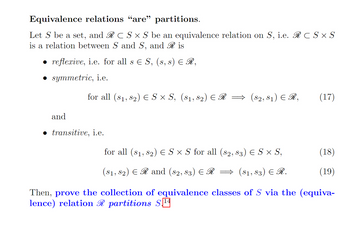
Advanced Engineering Mathematics
10th Edition
ISBN: 9780470458365
Author: Erwin Kreyszig
Publisher: Wiley, John & Sons, Incorporated
expand_more
expand_more
format_list_bulleted
Question
The numbers in the red box will have annotations below

Transcribed Image Text:Equivalence relations “are" partitions.
Let S be a set, and RC S × S be an equivalence relation on S, i.e. RC S × S
is a relation between S and S, and Ris
• reflexive, i.e. for all s € S, (s, s) ≤ R,
• symmetric, i.e.
and
for all (8₁, 82) € S × S, (S1, S2) ≤ R
transitive, i.e.
($2,81) € R,
for all (8₁, 82) € S × S for all (s2, 83) € S × S,
(81, 82) € R and (82, 83) € R
($1,$3) € R.
(17)
(18)
(19)
Then, prove the collection of equivalence classes of S via the (equiva-
lence) relation R partitions S1
![14Recall an equivalence class of S via the (equivalence) relation R is a subset of S, consisting
of elements, all of whom are related to one another (by R). More precisely (at the expense of
intuition!), an equivalence class of S via the (equivalence) relation R is a subset
(20)
TCS such that there exists t € S such that T = :{s € S|(s, t) ≤ R}.
We may choose, for each equivalence class T of S via the (equivalence) relation R, a repre-
sentative t € T, i.e. a specific element t € T to which all other elements of T are equivalent
via R, i.e. a specific element t € T such that for all s € T, (s, t) € R. Having selected a
representative, t, for an equivalence class T of S via the (equivalence) relation R, we may
denote T instead, more suggestively, by [t], which signifies “all of the elements of S which are
equivalent to t via the (equivalence) relation R.”"
-
For example, let S := Z × Z − {(0,0)} =: Zײ – {(0,0)} and R := {((x, y), (z, w)) €
Sx S|xw = yz} C S x S. We have shown (and you should check once more!) RC S x S is
an equivalence relation on S. The set
T := {..., (-3, −6), (−2, −4), (−1, −2), (1, 2), (2, 4), (3, 6), ...}
(21)
is an equivalence class of S via the (equivalence) relation R, and happens to be the equiv-
alence class of t := (1, 2) (ort := (−3, −6), or t := (−2, −4), or t := (−1, −2), or t := : (2,4),
or t := (3,6), etc.) Remind yourself that the equivalence classes of S via the (equivalence)
relation in this specific example do indeed partition S (into a collection of disjoint lines).](https://content.bartleby.com/qna-images/question/1797707a-0d96-41d6-8f45-19c20e886f5b/761e9534-46c4-4e93-be6c-e0d6821d771d/ik9jzft_thumbnail.png)
Transcribed Image Text:14Recall an equivalence class of S via the (equivalence) relation R is a subset of S, consisting
of elements, all of whom are related to one another (by R). More precisely (at the expense of
intuition!), an equivalence class of S via the (equivalence) relation R is a subset
(20)
TCS such that there exists t € S such that T = :{s € S|(s, t) ≤ R}.
We may choose, for each equivalence class T of S via the (equivalence) relation R, a repre-
sentative t € T, i.e. a specific element t € T to which all other elements of T are equivalent
via R, i.e. a specific element t € T such that for all s € T, (s, t) € R. Having selected a
representative, t, for an equivalence class T of S via the (equivalence) relation R, we may
denote T instead, more suggestively, by [t], which signifies “all of the elements of S which are
equivalent to t via the (equivalence) relation R.”"
-
For example, let S := Z × Z − {(0,0)} =: Zײ – {(0,0)} and R := {((x, y), (z, w)) €
Sx S|xw = yz} C S x S. We have shown (and you should check once more!) RC S x S is
an equivalence relation on S. The set
T := {..., (-3, −6), (−2, −4), (−1, −2), (1, 2), (2, 4), (3, 6), ...}
(21)
is an equivalence class of S via the (equivalence) relation R, and happens to be the equiv-
alence class of t := (1, 2) (ort := (−3, −6), or t := (−2, −4), or t := (−1, −2), or t := : (2,4),
or t := (3,6), etc.) Remind yourself that the equivalence classes of S via the (equivalence)
relation in this specific example do indeed partition S (into a collection of disjoint lines).
Expert Solution
This question has been solved!
Explore an expertly crafted, step-by-step solution for a thorough understanding of key concepts.
This is a popular solution
Trending nowThis is a popular solution!
Step by stepSolved in 3 steps with 3 images

Knowledge Booster
Similar questions
arrow_back_ios
arrow_forward_ios
Recommended textbooks for you
 Advanced Engineering MathematicsAdvanced MathISBN:9780470458365Author:Erwin KreyszigPublisher:Wiley, John & Sons, Incorporated
Advanced Engineering MathematicsAdvanced MathISBN:9780470458365Author:Erwin KreyszigPublisher:Wiley, John & Sons, Incorporated Numerical Methods for EngineersAdvanced MathISBN:9780073397924Author:Steven C. Chapra Dr., Raymond P. CanalePublisher:McGraw-Hill Education
Numerical Methods for EngineersAdvanced MathISBN:9780073397924Author:Steven C. Chapra Dr., Raymond P. CanalePublisher:McGraw-Hill Education Introductory Mathematics for Engineering Applicat...Advanced MathISBN:9781118141809Author:Nathan KlingbeilPublisher:WILEY
Introductory Mathematics for Engineering Applicat...Advanced MathISBN:9781118141809Author:Nathan KlingbeilPublisher:WILEY Mathematics For Machine TechnologyAdvanced MathISBN:9781337798310Author:Peterson, John.Publisher:Cengage Learning,
Mathematics For Machine TechnologyAdvanced MathISBN:9781337798310Author:Peterson, John.Publisher:Cengage Learning,


Advanced Engineering Mathematics
Advanced Math
ISBN:9780470458365
Author:Erwin Kreyszig
Publisher:Wiley, John & Sons, Incorporated

Numerical Methods for Engineers
Advanced Math
ISBN:9780073397924
Author:Steven C. Chapra Dr., Raymond P. Canale
Publisher:McGraw-Hill Education

Introductory Mathematics for Engineering Applicat...
Advanced Math
ISBN:9781118141809
Author:Nathan Klingbeil
Publisher:WILEY

Mathematics For Machine Technology
Advanced Math
ISBN:9781337798310
Author:Peterson, John.
Publisher:Cengage Learning,

